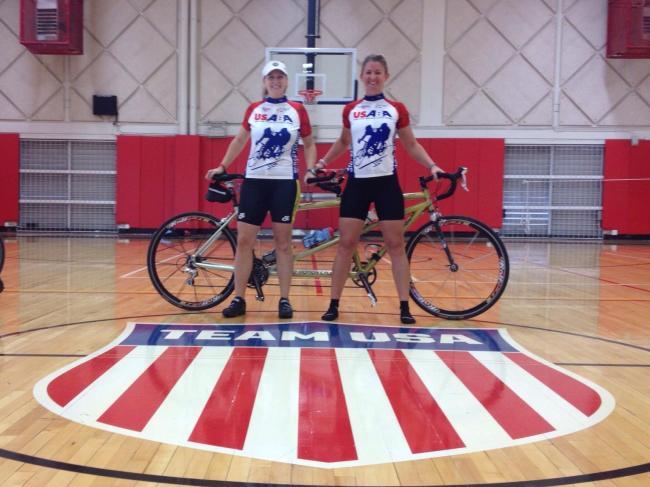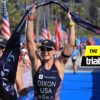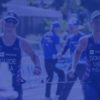“Mike, your shorts are inside-out. The bike chamois goes on the INSIDE,” Jimmy giggled aloud. The group gathered in the hallway of the Olympic training center dorms burst out into uncontrolled howls of laughter. “Well, why didn’t you tell me sooner? You know I’m BLIND, don’t you?” Mike started to crack up himself. One of the other cyclists chimed in, “Come on, Mike, you can’t FEEL that it’s wrong? Chamois; INSIDE.”
We stifled our giggles as the coach began his morning speech. “Riders; eyes and ears!” The crowded hallway fell silent. “Your bikes are loaded into the vans. We are going to drive out to the desert and ride 3 or 4 loops of tomorrow’s Time Trial Course. Be sure to ask lots of questions of the more experienced tandem teams, and note all the turns, lines, and opportunities to make up some speed. Any questions? Let’s roll.” And with that, ten Para Cycling teams made their way out into the Colorado cool spring air. Through my tiny pinhole of remaining eyesight, I could see the sun was just starting to strike the tip of Pike’s Peak, located another 8,000 feet above the Olympic Training Center of Colorado Springs.
Each team was made up of a sighted person piloting the front of the tandem bike, where they were left in charge of steering, braking, and shifting this elaborate racing bike built for two people. The second half of the team was a blind “stoker’, referring to the blind or visually impaired individual who helped power or ‘stoke’ the bike from the rear position. All of the pilots were volunteers with extensive cycling experience who had been recruited to this Para Cycling Development Camp in preparation for the upcoming Paralympics in Rio. The stokers, myself included, had been recruited from both military and civilian backgrounds as people who had shown an aptitude for tandem cycling and might have some interest in trying a racing career. It was an incredible honor to be surrounded by such a group.
Riding in the van, I because I have a tiny bit of vision left, I took the time to describe to my fellow blind stokers the terrain as we neared the course. “The mountains are to our West, covered in snow at the top, and the view around us is nothing but flat plains as far as the eye can see, dotted with cattle and the occasional new housing development and the Air Force Base, surrounded by high wire fencing.” We began to drive on the course, and the coaches began describing the turns to the riders without sight. “Here, you have a 110 degree turn, so take advantage of the shoulder, and you can afford to stay tight there.” Although the blind cyclists wouldn’t be in charge of steering the bike on any of the turns, it instilled confidence in each of us to know what was coming at every bend in the road, and how to stay in sync with our pilots to maintain the best aerodynamic position.
The van finally pulled over on a dead end street next to a tiny grouping of new homes. Our bikes were already being unloaded from the cargo van by our amazing volunteer mechanic, Dan. After making some last minute adjustments to our seat, my pilot Lindsey and I took our loaner CoMotion bike, “Palomino” out for a test ride. The air was frigid. Barely 45 degrees, and the flat plain made the wind chill absolutely biting. Where was the 70 degree weather of the day before? I prayed for the sun to hit this street, and soon. Over my bike shorts I had thermal tights, two long sleeve shirts, a wind jacket, and fuzzy gloves. I looked more prepared for skiing than going for a bike ride.
After three days of being together 24/7 and a good ten hours of time in the saddle, my pilot Lindsey and I were starting to really mesh as a team. We chatted like old friends, and had shortened our on-bike communications to mono-syllabic words to convey exactly what we either needed or were about to do. “Drinking!” I would pronounce before I carefully and smoothly leaned forward to grab my water bottle. “Shifting,” Lindsey would announce before an impending hill climb. “Right,” should would shout before a turn, or “bump!” before a giant pothole bruised my seat-bones. We became fluid, smooth and closer and closer to that singular unit that we knew we could achieve with simply more time spent together on the bike.
On our first climb of the 4 loop, rectangular 5km race course, our friend and mentor Greg Miller and his blind stoker pulled up alongside. With his Tennessee southern drawl, Greg explained the necessary strategy to ride the course most efficiently and safely. “You’ve just got to pick this line, drifting from out to in on these turns and push hard on this first uphill. With the tailwind, you should be hitting no less than 20mph here.” Lindsey and I listened intently as we softly pedaled alongside for our lesson.
The course turned right up a steeper incline, and he advised that we maintain this speed by standing up on the bike for a short burst. Lindsey and I both sighed as we hit the long gradual downhill. “Hey Greg this seems like a great spot to catch our breath after that hill!” I offered. “No way, man, “ said Greg, rather emphatically. “This is where you make up some speed. USE this hill to get going on the course. There is no rest in bike racing, young lady.” Both Lindsey and I couldn’t hide our disappointment, as it must have been written all over our faces. “Hey, ladies. If you want to make the time, you’re going to have to ride the shit out of this.” And with that, he pedaled forcefully ahead.
We finished our third loop, and were about to head out for one more, when my fingers finally went numb. Thankfully, Lindsey felt the same way, so we decided that we’d had enough of riding the windy, chilly course, and would go warm up in the waiting vans. Several other riders must have concurred, as there was a pretty large group gathered back on the side street as we arrived. We all chatted nervously, discussing strategy and info on the course, hoping that someone might offer new insight.
This time trial meant a lot to many of us. The USA Paracycling team has written standards in order to achieve recognition and funding for budding athletes. There is a military standard, an emerging standard, a talent pool standard, and finally a national standard, with the latter being the fastest. If we could hit the talent pool time standard after only 3 days of training as a team, Lindsey and I could get some much needed financial assistance and coaching to go further in the sport. After handing our ‘Palomino’ off to Dan for transport, we high-fived each other. “We’ve got this” we both said at once. “Jinx!”
If you want to help support this team, please click here:



